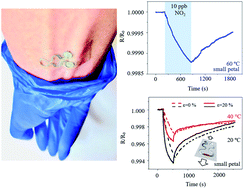当前位置:
X-MOL 学术
›
J. Mater. Chem. A
›
论文详情
Our official English website, www.x-mol.net, welcomes your
feedback! (Note: you will need to create a separate account there.)
Novel gas sensing platform based on a stretchable laser-induced graphene pattern with self-heating capabilities
Journal of Materials Chemistry A ( IF 10.7 ) Pub Date : 2020/01/08 , DOI: 10.1039/c9ta07855j Li Yang 1, 2, 3, 4, 5 , Ning Yi 6, 7, 8, 9 , Jia Zhu 7, 8, 9, 10 , Zheng Cheng 9, 11, 12, 13, 14 , Xinyang Yin 7, 8, 9, 15 , Xueyi Zhang 7, 8, 9, 15 , Hongli Zhu 9, 11, 12, 13 , Huanyu Cheng 6, 7, 8, 9, 10
Journal of Materials Chemistry A ( IF 10.7 ) Pub Date : 2020/01/08 , DOI: 10.1039/c9ta07855j Li Yang 1, 2, 3, 4, 5 , Ning Yi 6, 7, 8, 9 , Jia Zhu 7, 8, 9, 10 , Zheng Cheng 9, 11, 12, 13, 14 , Xinyang Yin 7, 8, 9, 15 , Xueyi Zhang 7, 8, 9, 15 , Hongli Zhu 9, 11, 12, 13 , Huanyu Cheng 6, 7, 8, 9, 10
Affiliation

|
Measurements of the gas sensing performance of nanomaterials typically involve the use of interdigitated electrodes (IDEs). A separate heater is often integrated to provide elevated temperature for improved sensing performance. However, the use of IDEs and separate heaters increases fabrication complexity. Here, a novel gas sensing platform based on a highly porous laser-induced graphene (LIG) pattern is reported. The LIG gas sensing platform consists of a sensing region and a serpentine interconnect region. A thin film of metal (e.g., Ag) coated in the serpentine interconnect region significantly reduces its resistance, thereby providing a localized Joule healing in the sensing region (i.e., self-heating) during typical measurements of chemoresistive gas sensors. Dispersing nanomaterials with different selectivity in the sensing region results in an array to potentially deconvolute various gaseous components in the mixture. The self-heating of the LIG gas sensing platform is first studied as a function of the applied voltage during resistance measurement and LIG geometric parameters (e.g., linewidth from 120 to 240 μm) to achieve an operating temperature from 20 to 80 °C. Systematic investigations of various nanomaterials demonstrate the feasibility of the LIG gas sensing performance. Taken together with the stretchable design layout in the serpentine interconnect region to provide mechanical robustness over a tensile strain of 20%, the gas sensor with a significant response (6.6‰ ppm−1), fast response/recovery processes, excellent selectivity, and an ultralow limit of detection (1.5 parts per billion) at a modest temperature from self-heating opens new opportunities in epidermal electronic devices.
中文翻译:

基于可拉伸激光诱导石墨烯图案并具有自加热功能的新型气体传感平台
纳米材料的气体感测性能的测量通常涉及使用叉指式电极(IDE)。通常会集成一个单独的加热器以提高温度,以提高感测性能。然而,IDE和单独的加热器的使用增加了制造复杂性。在此,报告了一种基于高度多孔的激光诱导石墨烯(LIG)模式的新型气体传感平台。LIG气体感应平台由一个感应区域和一个蛇形互连区域组成。蛇形互连区域中覆盖的金属薄膜(例如,Ag)显着降低了其电阻,从而在传感区域中提供了局部的焦耳愈合(即(自加热)在化学阻性气体传感器的典型测量中。在感测区域中分散具有不同选择性的纳米材料会导致阵列潜在地使混合物中的各种气态成分去卷积。首先根据在电阻测量期间施加的电压和LIG几何参数(例如,线宽从120到240μm)来研究LIG气体传感平台的自热,以达到20至80°C的工作温度。对各种纳米材料的系统研究证明了LIG气体传感性能的可行性。结合在蛇形互连区域中的可拉伸设计布局,可在20%的拉伸应变范围内提供机械强度,该气体传感器具有显着的响应(6.6‰ppm)-1),快速的响应/恢复过程,出色的选择性以及自加热适度温度下的超低检测限(十亿分之1.5)为表皮电子设备带来了新的机遇。
更新日期:2020-04-08
中文翻译:

基于可拉伸激光诱导石墨烯图案并具有自加热功能的新型气体传感平台
纳米材料的气体感测性能的测量通常涉及使用叉指式电极(IDE)。通常会集成一个单独的加热器以提高温度,以提高感测性能。然而,IDE和单独的加热器的使用增加了制造复杂性。在此,报告了一种基于高度多孔的激光诱导石墨烯(LIG)模式的新型气体传感平台。LIG气体感应平台由一个感应区域和一个蛇形互连区域组成。蛇形互连区域中覆盖的金属薄膜(例如,Ag)显着降低了其电阻,从而在传感区域中提供了局部的焦耳愈合(即(自加热)在化学阻性气体传感器的典型测量中。在感测区域中分散具有不同选择性的纳米材料会导致阵列潜在地使混合物中的各种气态成分去卷积。首先根据在电阻测量期间施加的电压和LIG几何参数(例如,线宽从120到240μm)来研究LIG气体传感平台的自热,以达到20至80°C的工作温度。对各种纳米材料的系统研究证明了LIG气体传感性能的可行性。结合在蛇形互连区域中的可拉伸设计布局,可在20%的拉伸应变范围内提供机械强度,该气体传感器具有显着的响应(6.6‰ppm)-1),快速的响应/恢复过程,出色的选择性以及自加热适度温度下的超低检测限(十亿分之1.5)为表皮电子设备带来了新的机遇。











































 京公网安备 11010802027423号
京公网安备 11010802027423号